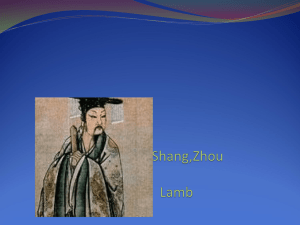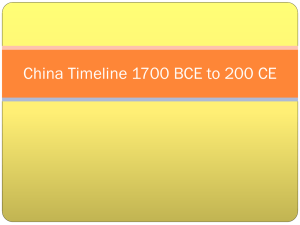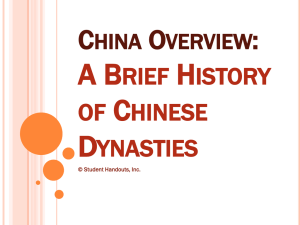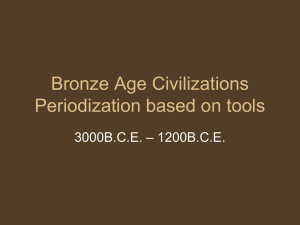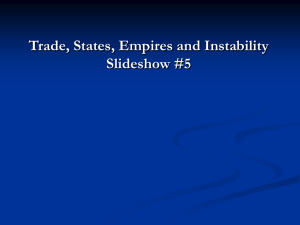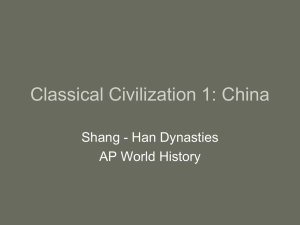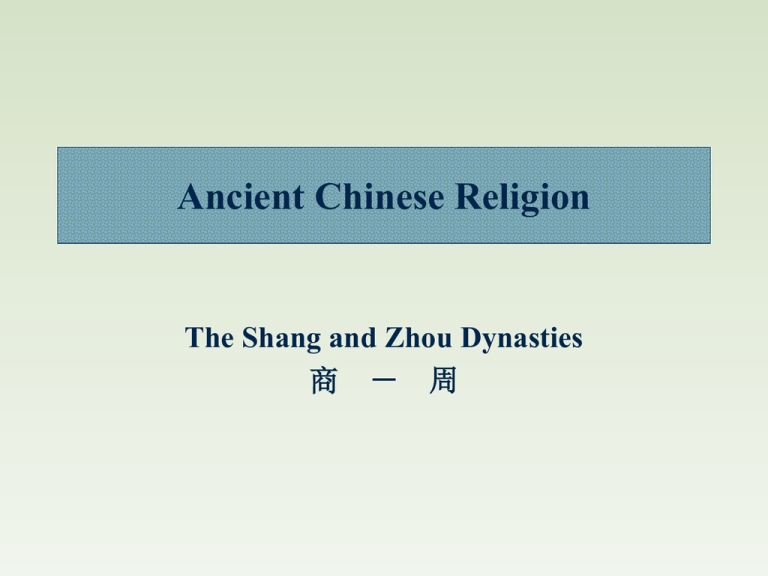
Ancient Chinese Religion
The Shang and Zhou Dynasties
商 - 周
Ancient Chinese Civilization
Prehistory
Prehistory
Yang-shao (6000-3000 BCE) 仰韶
Long-shan (3000-2000 BCE) 龍山
Mythic Period
“Tang Dynasty”
“Yü Dynasty”
“Xia Dynasty”
三皇五帝 (“dated” 2852-2205 BCE)
Huang-di (黄帝)
Zhuanxu (顓頊)
Emperor Ku (帝嚳)
Emperor Yao (堯)
Emperor Shun (舜)
Fuxi (伏羲)
Nüwa (女媧)
Shennong (神農)
Shang
Shang Dynasty
(1766 - 1122 BCE)
Beginning of Recorded History:
The Oracle Bones
Classical Period
Zhou Dynasty
(1040 - 256 BCE)
Western Zhou
Eastern Zhou
Spring & Autumn Period
Warring States Period
Laozi (? - ? BCE)
Zhuangzi (4th c BCE)
Kongzi (6th c BCE)
Mengzi (4th c BCE)
Xunzi (3rd c BCE)
Mozi (5th c BCE)
Qin
Qin (221-206 BCE)
"Burning of the books"
Shang and Zhou Religion
A.
Ancient Chinese Civilization (6000-2000 BCE)
The Pre-Historic Period
B.
The Shang Dynasty (1766-1122 BCE)
Shang Foundations of Modern Chinese Religion
C.
The Zhou Dynasty (1040-256 BCE)
A.
Ancient Chinese Civilization (6000-2000 BCE)
The Pre-Historic Period
B.
The Shang Dynasty (1766-1122 BCE)
Shang Foundations of Modern Chinese Religion
C.
The Zhou Dynasty (1040-256 BCE)
Archeological discoveries
周口店 Zhoukoudian (500,000 BCE)
仰韶 Yangshao (6000-3000 BCE)
龍山 Longshan (3000-2000 BCE)
周口店
仰韶文化
半坡
Yang-shao (6000-3000 BCE)
仰韶
Settlement around rivers
“Flash and burn” agriculture
Domesticated dogs, pigs, goats, silkworms
Supplemented diet with hunting & gathering
Stone implements
Grain storage pits within the houses
Painted pottery
Few weapons found
半坡, 4500 BCE (excavated 1954-57)
Houses of wood, straw, and mud, sometimes semisubterranean – doors facing south
Burial grounds separated from the village, some including
more than one village, suggesting regional kinship relations
No signs of social stratification in houses and graves
Burial of deer with humans, pottery and implements
龍山文化
Long-shan (3000-2000 BCE)
龍山
Permanently settled villages
Rammed earth walls
Irrigation
Rice, peaches, melons, peanuts, beans
Cattle, sheep, pigs, water buffalo
Wheel-made pottery
Weapons and fortified villages
Evidence of bone and shell divination
Developing social stratification
More elaborate burials
Yangshao and Longshan Cultural Contrasts
(from K.C. Chang, Archeology of Ancient China)
Yangshao (6000-3000)
Shifting settlements
Domesticated pigs & dogs
Geographically confined
Game-hunting tools
Handmade pottery
No defensive works
Burial practice indicating
age and sex differentiation
Evidence of “fertility cult”
Longshan (3000-2000)
Permanent settlements
Domesticated cattle & sheep
Far-reaching expansions
Harvesting tools
Wheel-spun pottery
Defensive walls & weapons
Burial practice indicating
social stratification
Evidence of “ancestral cult”
Evidence of Pre-historic Religion
(multiple Neolithic cultures)
tools
pottery
jade
Tomb offerings:
2. Placement of graves
3. Deer burial
4. Divination
1.
The Prehistoric Period
in Chinese Myth
The “Three Sovereigns and Five Emperors”
三皇五帝
Dating to the Han Dynasty (2nd c. BCE), but
purporting to describe events ca. 3000 BCE
三皇五帝
Fuxi (伏羲)
Nüwa (女媧)
Shennong (神農)
•
•
•
•
•
Huang-di (黄帝)
Zhuanxu (顓頊)
Emperor Ku (帝嚳)
Emperor Yao (堯)
Emperor Shun (舜)
Legends of Fu-xi 伏羲
China’s “First Emperor”
First of the 三皇 “Mythical Emperors”
Survivor of the great flood -- “inventor”
of fishing, trapping, writing, civilized
domestic life
With sister Nű-wa (女媧 – second of the
三皇), procreator of humankind, making
companions of clay
“伏羲坐像”
馬麟 (13th c.)
Legends of Fu Xi
In the beginning there was as yet no moral or
social order. Men knew their mothers only, not
their fathers. When hungry, they searched for
food; when satisfied, they threw away the
remnants. They devoured their food hide and hair,
drank the blood, and clad themselves in skins and
rushes.
Then came Fu Xi 伏羲 and looked upward and
contemplated the images in the heavens, and
looked downward and contemplated the
occurrences on earth. He united man and wife,
regulated the five stages of change, and laid down
the laws of humanity. He devised the eight
trigrams, in order to gain mastery over the world.
Ban Gu, Baihu tongyi (白虎通義), Han Dynasty
(trans. by Richard Wilhelm)
Perhaps corresponding to what period?
Legends of Shen-nong
神農
-- third of the 三皇
“The ancient people ate meat of animals and birds.
[When] there were so many people that the animals and
birds became inadequate for the people’s needs, Shen-nong
taught the people to cultivate.
“There was a red bird holding in its mouth a cereal stalk
with nine ears. Some of the grains fell to the ground.
Millet rained from heaven. Shen-nong picked them up and
cultivated them in the field. Those who ate the grains lived
long and did not die.
“Shen-nong invented wooden agricultural implements and
taught the whole world his inventions. He instituted the
market held at noon. He administered all the peoples of
the world and gathered their produce in the markets. After
exchanging their goods, the people went back to their
homes and rested contented”
•
Translated by K.C. Chang, The Archaeology of Ancient China (1963)
Shu-jing 書經 (Western Han)
Perhaps corresponding to what period?
The Divine Farmer‘s Herb-Root Classic
(神農本草經)
Dating to Western Han (2nd c. BCE)
but attributed to Shennong
A Taoist foreshadowing?
Place in the Taoist Canon
A.
Ancient Chinese Civilization (6000-2000 BCE)
The Pre-Historic Period
B.
The Shang Dynasty (1766-1122 BCE)
Shang Foundations of Modern Chinese Religion
C.
The Zhou Dynasty (1040-256 BCE)
Ancient Chinese Civilization
三皇五帝 (“dated” 2852-2205 BCE)
Mythic Period
“Tang Dynasty”
“Yü Dynasty”
“Xia Dynasty”
Huang-di (黄帝)
Zhuanxu (顓頊)
Emperor Ku (帝嚳)
Emperor Yao (堯)
Emperor Shun (舜)
Fuxi (伏羲)
Nüwa (女媧)
Shennong (神農)
Shang
Shang Dynasty
(1766 - 1122 BCE)
Beginning of Recorded History:
The Oracle Bones
Classical Period
Zhou Dynasty
(1040 - 256 BCE)
Western Zhou
Eastern Zhou
Spring & Autumn Period
Warring States Period
Qin (221-206 BCE)
Kongzi (6th c BCE)
Mengzi (4th c BCE)
Xunzi (3rd c BCE)
Laozi (? - ? BCE)
Zhuangzi (4th c BCE)
Mozi (5th c BCE)
"Burning of the books"
The Shang 商 Dynasty
(1766-1122 BCE)
1.
2.
3.
4.
5.
6.
Hereditary kings
Large landholdings
Armed warfare
Human sacrifice
Earliest writing
Bronze casting
Shang Dynasty Religion
Shangdi 上帝
Royal Ancestors
Nature Spirits
Interaction with Deities
Sacrifices
Divination
Oracle Bones
1. Materials
2. Inscriptions
3. Procedure
4. Contents
5. Values and themes
Takashima Kenichi
Plastron shell
1
Oracle-bone Inscriptions
Ox scapula
2
1.
Preface/postface: time, diviner,
place
2.
Questions: prayers, predictions, or
plans
3.
The prognostication: interpretation
of the cracks by the king
4.
Verification: confirming accuracy
Preface
On the day gui-hai (60th
day), the king made cracks
and divined: “In the next
10 days there will be no
disasters.” The king read
the cracks and said:
“Auspicious.”
prognostication
verification
3
On the day gui-zhou (50th
day), the king made cracks
and divined: “In the next
10 days there will be deer
[from the hunt].” The king
read the cracks and said:
“Auspicious.”
Let’s play
Guess the Glyph*!
*A sculptured mark or symbol
(Oxford English Dictionary)
Shang Inscriptions 甲骨文 jiǎgǔwén
Shang Inscriptions 甲骨jiǎgǔ文
Shang Inscriptions 甲骨jiǎgǔ文
Contents of Oracle-bone inscriptions
sacrifices
military campaigns
hunting expeditions
excursions
the coming ten-day week
the coming night or day
the weather
agriculture
sickness
4
childbirth
distress and trouble
dreams
settlement building
orders
tribute payments
divine assistance or
approval
requests addressed to
ancestral or nature powers
Values and themes
1.
2.
3.
4.
5
Whenever possible,
cracks were interpreted
auspiciously
Only verifications were
recorded, never errors,
emphasizing the power
and accuracy of the king
Complementarity: reality
as a series of balanced
dualisms
Use of writing as a
religio-political tool
Abiding features of Shang religion
Centrality of ancestor worship / spirits of the dead
Bureaucratization of the afterworld
Offerings of meat, grain, and wine
Ritualization of nature
Continuum of heaven and earth,
dead and living (the cosmos as an inter-related whole)
Reciprocity, mutuality
Priestly / magical power over the spirit world
A.
Ancient Chinese Civilization (6000-2000 BCE)
The Pre-Historic Period
B.
The Shang Dynasty (1766-1122 BCE)
Shang Foundations of Modern Chinese Religion
C.
The Zhou Dynasty (1040-256 BCE)
Ancient Chinese Civilization
三皇五帝 (“dated” 2852-2205 BCE)
Mythic Period
“Tang Dynasty”
“Yü Dynasty”
“Xia Dynasty”
Huang-di (黄帝)
Zhuanxu (顓頊)
Emperor Ku (帝嚳)
Emperor Yao (堯)
Emperor Shun (舜)
Fuxi (伏羲)
Nüwa (女媧)
Shennong (神農)
Shang
Shang Dynasty
(1766 - 1122 BCE)
Beginning of Recorded History:
The Oracle Bones
Classical Period
Zhou Dynasty
(1040 - 256 BCE)
Western Zhou
Eastern Zhou
Spring & Autumn Period
Warring States Period
Qin (221-206 BCE)
Kongzi (6th c BCE)
Mengzi (4th c BCE)
Xunzi (3rd c BCE)
Laozi (? - ? BCE)
Zhuangzi (4th c BCE)
Mozi (5th c BCE)
"Burning of the books"
Zhou Dynasty
(1122 BCE – 256 BCE)
1122-771 BCE
(capitals: various)
770-256 BCE
(capital: Luoyang)
Dating
All dates B.C.E.
商 朝 Shang Dynasty
1766-1122
西 周 Western Zhou (Chou) Dynasty 1122-771
東 周 Eastern Zhou (Chou) Dynasty 770-256
Shang
W. Zhou
春 秋 Spring & Autumn Period 722-481
戰 國 Warring States Period 403-221
E. Zhou
Spring & Autumn
Warring States
Zhou Dynasty Religion
Heaven (天 Tian) :
the Zhou high god,
increasingly “depersonalized”
Ancestor worship
(spirits of the dead)
The cult of the Earth
(“nature” spirits)
The Mandate of Heaven 天命
Shang overthrow (1066 BCE)
Religious justification: “For his many crimes, the
King of Shang has been punished by Heaven.
Heaven is going by means of me to rule the
people.” (史記 Shi ji – Book of History)
Divine/Moral right to rule
Speaking to the Shang nobles, the
Duke of Zhou explained:
天命
King Wu of Zhou possessed a
mandate which said, ‘Destroy the
Shang Dynasty.’ Because our
actions did not go contrary to
Heaven’s course of action, your
Royal House has come under our
control.
I will explain it to you. Your ruler
was greatly lawless. Our house did
not originate this movement against
your house. It came from your own
court. When I reflect that Heaven
has applied such great severity to the
Shang ruler, it shows that he was not
upright.”
From the 書經 Shu jing
(Book of Documents)
See Ivanhoe and Van Norden, pp. xiii-xiv
Popular deities of the Eastern Zhou
God of the hearth
Deities of city gates and city
walls, roads
Deities of stars and
constellations, sun, moon
Deities of mountains and rivers,
wind and rain
Religious specialists of the Eastern Zhou
Diviners
Dream-interpreters
Interpreters of
extraordinary phenomena
Exorcists
Shamans
Dating
All dates B.C.E.
商 朝 Shang Dynasty
1766-1122
西 周 Western Zhou Dynasty 1122-771
東 周 Eastern Zhou Dynasty 770-256
Shang
W. Zhou
春 秋 Spring & Autumn Period 722-481
戰 國 Warring States Period 403-221
E. Zhou
Spring & Autumn
Warring States
The
Warring
States
Period
(403-221)
Religious Decline of the Warring States Period
Decline of royal ancestral rites
Decline in power of the royal
ancestors
Use of religion for political
purposes
Idea of “individual mandates”
Strengthening of the “Six
Schools”
Growing allegiance to nature
deities of localities
Growing religious skepticism
Religious Decline of the Warring States Period
Shi jing 204
Shi jing 272
詩經
Growing religious skepticism:
Heaven is violent and terrifying. He does not foresee, He does not
calculate the future. He pardons those who have committed crimes.
Even those who have already expiated their sins as well as those who
have committed no crimes at all are [still] made to suffer.
Heaven is not just. He sends down these great quarrels. Heaven is
not kind. He sends down these great oppressions. Heaven is not just.
From the 詩經 Shi jing (Book of Poetry)
-- trans. by Homer Dubs
The Birth of Philosophy in
the Warring States Period (403-221 BCE)
1.
Ru 儒 家 Confucians (known as “Ritualists” or “Scholars,” “Erudites”):
dedicated to the restoration of political and social conditions established by the
Duke of Zhou centuries earlier (Kongzi, Mengzi, Xunzi)
2.
Mo 墨 家 Mo-ists: followers of the philosopher Mozi who taught the doctrines
of radical pacificism and “universal love” (Mozi)
3.
Fa 法 家 Realists (or “Legalists”): dedicated to a Real-politik of political
power, social control, and law and order (Han Feizi)
4.
Dao 道 家 Dao-ists: recluses who rejected shi status, “civil” society and its
values (“Laozi,” Zhuangzi)
5.
Ming 名家 School of Names (or “Dialecticians,” “Logicians,” “Sophists”):
dedicated to the study of language and logic, perhaps as a rejection of political
engagement (Gongsun Longzi, Huizi)
6.
Fang-shi 方 士 Yin-yang Cosmologists: dedicated to the study of the cosmos
and its interrelations (many)
The Qin Dynasty (221-206 BCE)
焚書坑儒 Fénshū Kēngrú
"相李斯曰:「臣請史官非秦記皆燒之。非博士官所職,天下敢有D詩、書、百家語者
,悉詣守、尉雜燒之。有敢偶語詩書者棄市。以古非今者族。吏見知不舉者與同罪。
令下三十日不燒,黥為城旦。所不去者,醫藥卜筮種樹之書。若欲有学法令,以吏为
师」", from Shiji Chapter 6. “The Basic Annals of the First Emperor of Qin,” thirty fourth
year (213 BC).
Chancellor Li Si Said: "I, your servant, propose that all historian's records other than those
of Qin's be burned. With the exception of the academics whose duty includes possessing
books, if anyone under heaven has copies of the Shi Jing, the Classic of History, or the
writings of the hundred schools of philosophy, they shall deliver them (the books) to the
governor or the commandant for burning. Anyone who dares to discuss the Shi Jing or the
Classic of History shall be publicly executed. Anyone who uses history to criticize the present
shall have his family executed. Any official who sees the violations but fails to report them is
equally guilty. Anyone who has failed to burn the books after thirty days of this
announcement shall be subjected to tattooing and be sent to build the Great Wall. The books
that have exemption are those on medicine, divination, agriculture and forestry. Those who
have interest in laws shall instead study from officials.
"於是使御史悉案問諸生,諸生傳相告引,乃自除。1犯禁者四百六十餘人,皆阬之咸陽
,使天下知之,以懲後。益發謫徙邊。始皇長子扶蘇諫曰:「天下初定,遠方黔首未
集,諸生皆誦法孔子,今上皆重法繩之,臣恐天下不安。唯上察之。」",
from Shiji chapter 6.
The first emperor therefore directed the imperial censor to investigate the scholars one by
one. The scholars accused each other, and so the emperor personally determined their fate.
More than 460 of them were buried alive at Xianyang, and the event is announced to all under
heaven for warning followers. More people were internally exiled to border regions. Fusu, the
eldest son of the emperor, counselled: "The empire just achieved peace, and the barbarians in
distant areas have not surrendered. The scholars all venerate Confucius and take him as a role
model. Your servant fears if Your Majesty punish them so severely, it may cause unrest in the
empire. Please observe this, Your Majesty." (1Punctuation and therefore translation is
ambiguous here. Punctuation given here reflects the 1959 Zhonghua Shuju (中華書局)
edition.)
Review
Earliest archeological evidence suggests religious beliefs and practices surrounding
death and afterlife (“ancestor worship”)
Pre-historical religion suggests social stratification
Han Dynasty myths of the “Three Sovereigns and Five Emperors” recall Neolithic
features of hunting-and-gathering and early-settlement societies
Writing appears in the Shang Dynasty in oracle bone inscriptions
The oracle bones indicate the religious power of the king, emphasis on divination, and
dualistic conceptualization of reality
The Zhou overthrow is justified by appeal to the “Mandate of Heaven”
The “birth of philosophy” is tied to the Six Schools of the Eastern Zhou Dynasty
The Warring States Period (later Eastern Zhou) witnesses religious decline and the
depersonalization of Heaven
Few philosophical-religious movements are spared the “burning of the books” of the
First Emperor of Qin

